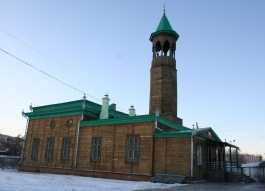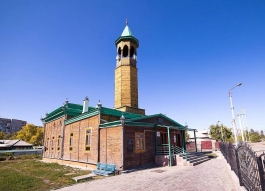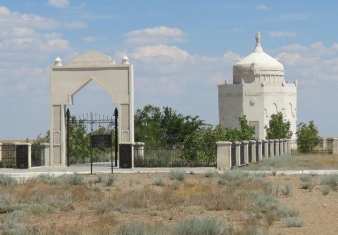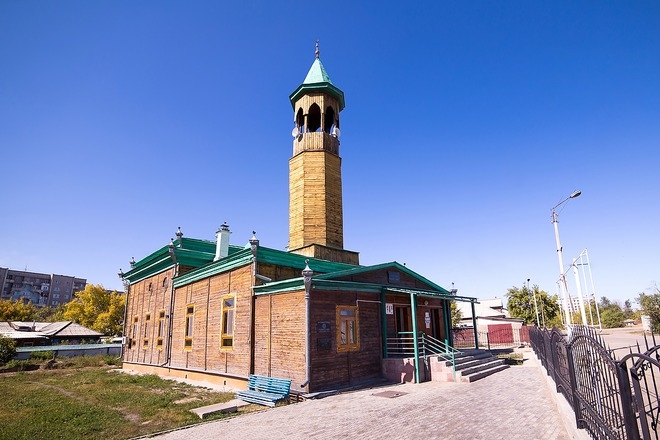
 Cultural heritage
Cultural heritage
50.4049, 80.2826
The mosque of Tynybay Kaukenov is a monument of architecture of the middle of the 19th century and is located in a left-bank part of the city of Semey, about the river station. The mosque is built in 1830-40 at the expense of the Kazakh merchant 2 guilds of Tynybaya Kaukenov.
Tynybay Kaukenov, the Kazakh from the sort "uak", was a merchant of the second guild of merchants. Archival material of 1839 on August 22 "The report on a condition of the Kyrgyz wandering above the city of Semipalatinsk" demonstrates to it: "... one Semipalatinsk Kyrgyz Tynybay Kaukenov trading in the steppe, I have managed to acquire the decent capital and I have built the house in the city, since 1839 I have registered already in merchants on the third guild".
In the archive of Kazakhstan archiving of 1842 under the name "Case of Reckoning of the Foreman of the Uvakovsky Volost of Kaukenova in Merchants of the City of Semipalatinsk" has remained. Above and above the listed contemporary records confirm that T. Kaukenov really lived in the city of Semipalatinsk. Being a merchant, he has constructed a house on the left coast of Irtysh.
Near the house, I have begun to construct the prayful mosque. T. Kaukenov has lived prior to the beginning of the XX century. From 70th years from the third guild, he is transferred to the second guild.
About the history of the mosque of T. Kaukenov, there are records found in the State archive of Kazakhstan. According to the sheet completed on May 6, 1858 "About the number of Mohammedan mosques and parishioners of men's - a female in the city of Semipalatinsk", in T. Kaukenov's mosque of male parishioners was 145, a female - 137. Referring to reliable contemporary records, it is supposed that the mosque is built in 1840.
The base of the mosque has been created stone, and walls to a minaret dome - wooden. In the mosque two-story halls are created, the first floor is intended for a prayer of men, top — for women. The dome and a part of an external wall are decorated with a carving of a different form. The architecture of a monument belongs to a type of so-called "Siberian Tatar" mosques, by the principle of construction is very similar to monuments of orthodox cult architecture when on one axis different-sized components are strung.
The distinction consisted mainly, in forms of the dome and vertical completion traditional for Islam. The minaret crowns a part of the mosque similar to "refectory" or an antichurch in the Russian church architecture. Chetverik of the main volume in Orthodoxy complemented by small quarters, in Islamic architecture is, as a rule, decorated with the similar addition with a bit different interpretation of a dome covering.
Walls of the mosque are avariciously decorated. They are recovered by square window openings, and also the light of the top tier of the main volume serving for the lighting of the room for women. An additional decor is an oven also the drain pipes decorated with an intricate pattern. Now on the left side of the mosque, there are rooms for ablution and also the additional rooms built of a white silicate brick for training.

In 50 km from the modern city of Atyrau, there is one of perspective tourist routes, regional memorial estate "Khan Ordaly Sarajshyk" who opens all ancient history of the Kazakh people.
The grave site of the great Kazakh poet of the 19th century, free-thinker and inspirer of the rebellion of Makhambet Utemisov is situated in Inder, Atyrau region, 40 km to the south-east from the village Inderbor.
Atyrau region is rich in its architectural monuments of culture, one of them is considered to be Zhuban Mausoleum.

Senek reserve is an architectural monument of the XVII - XX centuries, it represents a necropolis consisting of several sepulchral constructions and an old mosque.
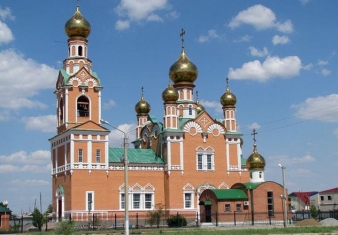
One of the oldest and most beautiful architectural monuments of the city - Uspenski Cathedral is located in the heart of the city of Atyrau, on Issatay Taimanov street, just a few steps from the main square.
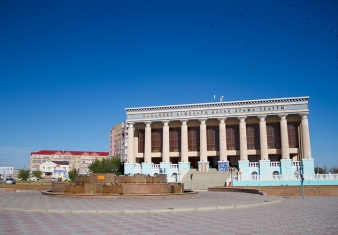
One of the leading places in the cultural life of Atyrau and the whole Atyrau region belongs to the Kazakh Drama Theater named after Makhambet Utemisov.














